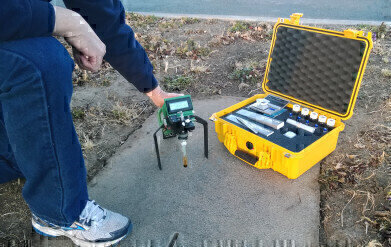Air Monitoring
New Trace Chemical Analyser for Onsite Analysis
Oct 28 2014
Quantitech (UK) has announced the launch of the FROG-4000, a rugged, portable instrument capable of analysing trace levels of individual volatile organic compounds (VOCs) in air, soil and water. “With this technology, operators will be able to conduct fast on-site analysis in a range of environmental, health and safety applications,” says Quantitech’s Dr Andrew Hobson. “The ability to analyse VOCs quickly, on-site, is a major benefit; partly, because samples containing volatiles are notoriously difficult to transport, but also because many applications require instant data. For example, land remediation companies need to know which soil is contaminated so that they can either store or treat it, and they need to know if treatment was successful. They may also need to test liquid effluent against a discharge permit.
“Analysis in a UKAS laboratory is often required for a small number of samples, but the advantage of a field-use device is that a large number of tests can be undertaken in order to characterise a site and identify hot-spots.”
VOCs are an important group of pollutants because they are very common in old contaminated industrial sites and they are also key components in modern materials such as paint, coatings, cleaners, adhesives, petrochemicals and a wide variety of household and building products. They vary greatly in their health effects; from mild irritation in sensitive individuals to cancer, from benzene exposure for example. VOCs also damage the environment, causing harm to most forms of life and contributing to photochemical ozone pollution.
There are four key components of the FROG-4000. A heated micro pre-concentrator dramatically increases sensitivity – down to single figure ppb. A miniature gas chromatograph (GC) enables speciation of multiple compounds and a micro photoionisation detector (PID) provides an accurate reliable response to almost all VOCs. The fourth important component is a 5ml sample sparger that is used to extract gaseous samples from water or solid materials.
Portable PID instruments are commonly employed to detect chemical leaks or contaminated soil, but they respond in different ways to different compounds. For example, most PIDs are around 20 times less sensitive to ethanol than they are to benzene or toluene. This means that it is NOT possible to quantify levels of sample VOCs when there is a possibility of more than one VOC being present, UNLESS a GC is employed to separate the individual compounds.
Weighing less than 2.5Kg and running for up to 6 hours on an internal battery, the FROG-4000 has been designed for field use. Typical analysis time is 5 minutes and results can be stored on an SD card or transferred directly to a laptop/PC.
Summarising, Dr Hobson says: “Last year we launched a portable GC/MS, so the addition of a PID GC to our range is a major advantage because it significantly lowers the cost of analysis for those that only need to analyse VOCs. However, the main advantage of these portable field-use technologies is the same – faster results.”
Digital Edition
IET 34.2 March 2024
April 2024
Gas Detection - Biogas batch fermentation system for laboratory use with automatic gas analysis in real time Water/Wastewater - Upcycling sensors for sustainable nature management - Prist...
View all digital editions
Events
Apr 30 2024 Melbourne, Australia
Apr 30 2024 Birmingham, UK
May 03 2024 Seoul, South Korea
May 05 2024 Seville, Spain
May 06 2024 Minneapolis, MN, USA


















